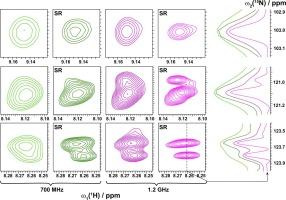Spectral resolution is one of the limiting factors in nuclear magnetic resonance (NMR) spectroscopy of biological systems where signal overlap often interferes with chemical shift assignment as well as dynamics and structure analysis. This problem can be addressed in part by using higher magnetic field NMR spectrometers operating at up to 1.2 GHz 1H frequency to enhance the resolution proportionally with the field strength, and by deuteration in combination with transverse relaxation-optimized spectroscopy that reduces the transverse relaxation rate and proportionally the resonance linewidth of the peaks yielding higher spectral resolution. As a complement or alternative to these expensive and often insufficient approaches, we present here a generally applicable method to reduce the linewidth of peaks in indirect dimensions of multi-dimensional NMR spectra by increasing the number of scans per time increment exponentially as a function of time in order to compensate, in part, the decay of the signal caused by transverse relaxation. This enables to achieve a user-defined linewidth of the peaks without undue increase of the noise. Optimization by including in the number of scans also a cosine apodization function as well as processing spectra with an exponential-cosine window function in the direct dimension results typically in a resolution enhancement (linewidth reduction) by a factor of 1.5–2 in comparison to a standard measurement with a constant number of scans per time increment. This is comparable to the 2-fold resolution enhancement that can be obtained by going from a 600 MHz 1H frequency NMR spectrometer to a 1.2 GHz instrument, or from 1.2 GHz to a spectrum measured hypothetically at 2.4 GHz 1H frequency. A factor of two resolution enhancement causes thereby a signal to noise loss of a factor of three. The sensitivity gain by dynamic number of scan sampling is thereby ∼20 % over the use of a digital apodization function.


